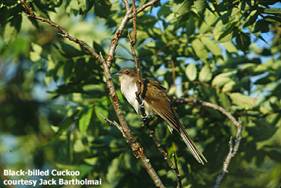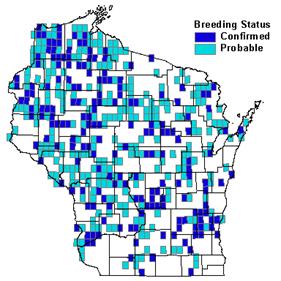

Status/Protection
- Global Rank: G5 Key to global and state ranks
- State Rank: S4B, SZN
- WBCI Priority: SGCN, PIF
Population Information
Federal BBS information can be obtained at http://www.mbr-pwrc.usgs.gov/bbs/bbs.html by clicking on Trend Estimates and selecting the species in question. All estimates are for 1966-2005.
- Federal Breeding Bird Survey: significant decline
- Federal Breeding Bird Survey (WI): significant decline
- Federal Breeding Bird Survey (BCR 23): significant decline
- Federal Breeding Bird Survey (BCR 12): non-significant increase
- WSO Checklist Project: stable (1983-2007)
Life History
- Breeding Range: Throughout southern Canada and U.S. states east of the Rockies (Hughes 2001).
- Breeding Habitat: Shrub-carr, Alder Thicket, Grassland-shrub, Pine Barrens, Northern Hardwood, Bottomland Hardwoods, early seral deciduous habitat.
- Nest: Platform, generally 1-2 meters above ground.
- Nesting Dates: EGGS: late May to mid-August (WSO 1995).
- Foraging: Foliage glean (Ehrlich et al. 1988).
- Migrant Status: Neotropical migrant.
- Habitat use during Migration: Woodlands and thickets, parks, gardens, mangroves, both humid and dry tropical forests (Hughes 2001).
- Arrival Dates: Early May to early June (Robbins 1991).
- Departure Dates: Mid-August to late September (Robbins 1991).
- Winter Range: Northern South America, including Columbia, Venezuela, Ecuador, and Peru (DeGraaf and Rappole 1995).
- Winter Habitat: All types of tropical forest and scrub; predominately below 1000 meters, but up to 3950 meters elevation (Hughes 2001).
Habitat Selection
The Black-billed Cuckoo occurs in woodlands, forest edges, and thickets. In the Midwest, it frequents upland and lowland shrub-carr, especially hawthorn and willow thickets (Robbins 1991). It nests in deciduous and mixed deciduous-coniferous woodlands near lakes or streams and less often in coniferous forests. Occasionally, Black-billed Cuckoos nest in urban parks or gardens (Peck and James 1983).
Gale et al. (1999) found that both Black-billed and Yellow-billed Cuckoos appeared on Breeding Bird Survey (BBS) routes (where they had not been previously detected) two years prior to an outbreak of gypsy moth, and then disappeared immediately after the outbreak. Although the sample size of this study was small, it does suggest that food resources affect Black-billed Cuckoo habitat selection.
Habitat Availability
Much suitable habitat remains in the state for Black-billed Cuckoo. Alder thicket is common and widespread in northern and central Wisconsin, but also occurs at isolated locales in the southern part of the state. Shrub-carr remains common and widespread in southern Wisconsin, but also occurs in the north (WDNR 2005). Abundant deciduous and mixed forest habitats exist statewide; however, forest fragmentation in both northern and southern Wisconsin, as well as on the wintering grounds, may make habitat unsuitable in some areas.
Population Concerns
Although abundant suitable habitat exists in Wisconsin, BBS data suggest significant declines within the state and range-wide (Sauer et al. 2005). Black-billed Cuckoo densities fluctuate annually in response to insect outbreaks, especially those of tent caterpillars or cicadas (Hughes 2001). BBS data reflect this phenomenon in Wisconsin, with number of individuals per BBS route varying from 0.7 to 3.0, and exhibiting an 8 to 9 year cycle. Wisconsin Breeding Bird Atlas data showed Black-billed Cuckoos to be widely distributed throughout Wisconsin. During the six-year census period (1995-2000), observers recorded evidence of breeding in 56% of the surveyed quads. (Anderson 2006).
Factors causing the population declines of this species are not well understood. Indiscriminate spraying to combat gypsy moth larva could adversely affect other caterpillar concentrations, thus reducing available prey (Anderson 2006). Black-billed Cuckoos also may suffer from pesticide poisoning by ingesting caterpillars from treated areas (Hughes 2001).
Recommended Management
Management efforts for this species should focus on creating and maintaining upland and lowland shrub communities. Conserve large blocks of forest that are subject to natural processes and various levels of disturbance. Spraying programs intended for tent caterpillars should be curtailed or reduced in Black-billed Cuckoo habitat (Hughes 1999).
Conservation and management strategies for this species should be focused in the following Wisconsin ecological landscapes: Central Lake Michigan Coastal, Central Sand Hills, Central Sand Plains, Forest Transition, North Central Forest, Northeast Sands, Northern Lake Michigan Coastal, Northwest Sands, Southeast Glacial Plains, Superior Coastal Plain, and Western Coulee and Ridges (WDNR 2005).
Research Needs
Research is needed to determine the factors of long-term population decline of this species. Among those of greatest concern are the effects of pesticide use on foraging cuckoos and habitat fragmentation or modification (Hughes 2001). Since 70% of Wisconsin forests are privately owned, research is needed to study whether smaller private holdings can provide habitat if managed as early seral deciduous types (WDNR 2005).
Information Sources
- Chequamegon National Forest Bird Survey (NRRI) species account: http://www.nrri.umn.edu/mnbirds/accounts/BBCUa2.htm
- Western Great Lakes Bird Conservation probability map http://www.uwgb.edu/birds/greatlakes/species/bbcumap2.htm
- Nicolet NF bird survey map: http://www.uwgb.edu/birds/nnf/species/BBCU.htm
- North American Breeding Bird Survey: http://www.npwrc.usgs.gov
- Temple S.A., J.R. Cary, and R. Rolley. 1997. Wisconsin Birds: A Seasonal and Geographical Guide. Wisconsin Society of Ornithology and Wisconsin Department of Natural Resources, Madison, WI.
- Wisconsin Breeding Bird Atlas: www.uwgb.edu/birds/wbba/
References
- Anderson, J. 2006. Black-backed Woodpecker. In Atlas of the Breeding Birds of Wisconsin. (N.J. Cutright, B.R. Harriman, and R.W. Howe, eds.) The Wisconsin Society for Ornithology, Inc. 602pp.
- DeGraaf, R.M. and J.H. Rappole. 1995. Neotropical migratory birds: natural history, distribution, and population change. Comstock Publ. Assoc., Cornell Univ. Press, Ithaca, NY.
- Ehrlich, P.R., D.S. Dobkin, and D. Wheye. 1988. The birders handbook: a field guide to the natural history of North American birds. Simon & Schuster, Inc. New York.
- Gale, G.A., J.A. DeCecco, M.R. Marshall, W.R. McClain, and R.J. Cooper. 1999. Effects of gypsy moth defoliation on forest birds: an assessment using breeding bird census data. J. Field Ornithology 72(2): 291-304.
- Hughes, J.M. 2001. Black-billed Cuckoo (Coxxyzus erythropthalmus). In The Birds of North America, No. 587 (A.Poole and F. Gill, eds.). The Birds of North America, Inc., Philadelphia, PA.
- Peck, G.K. and R.D. James. 1983. Breeding birds of Ontario: nidology and distribution. Vol. 1: non-passerines. R. Ontario Mus. Life Sci. Misc. Publ., Toronto.
- Rappole, J.H. 1995. The ecology of migrant birds. Smithsonian Institution Press, Washington, D.C.
- Robbins, S.D. 1991. Wisconsin birdlife: population & distribution, past & present. Univ. of Wisc, onsin Press, Madison, WI.
- Sauer, J.R., J.E. Hines, and J. Fallon. 2005. The North American Breeding Bird Survey, Results and Analysis 1966 - 2005. Version 6.2.2006. USGS Patuxent Wildlife ResearchCenter, Laurel, MD.
- Wisconsin Department of Natural Resources (WDNR). 2005. Wisconsin’s Strategy for Wildlife Species of Greatest Conservation Need. Madison, WI.
- Wisconsin Society for Ornithology. 1995. Wisconsin breeding bird atlas; atlasing handbook 1995-1999. Wisconsin Society for Ornithology, Inc., Hartland, WI.
Contact Information
- Compiler: William P. Mueller, iltlawas@earthlink.net
- Editors: Rick Anderson, Rick.Anderson@co.clark.wi.us | Kim Kreitinger, K.Kreitinger@gmail.com
